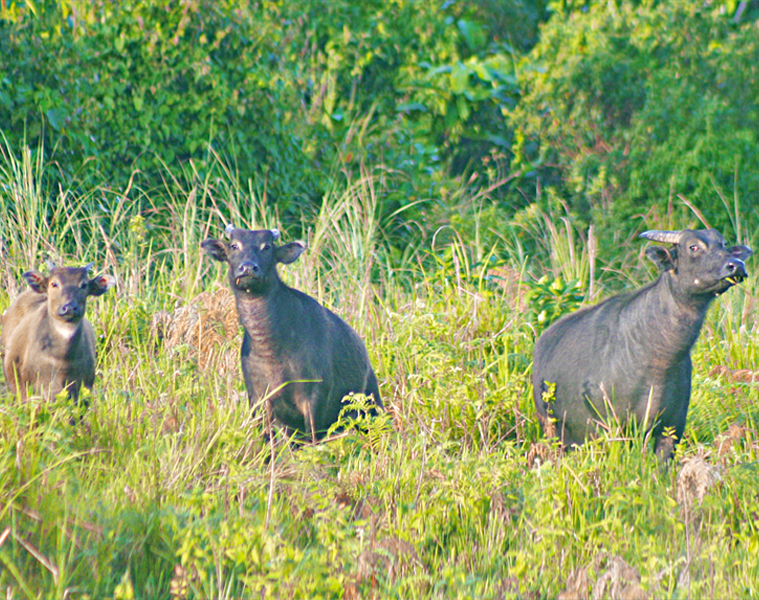Travel diary: Tamaraw-spotting in Mindoro

I am a bush. Heavily-camouflaged by a sniper’s Ghillie Suit and betrayed only by the scarlet glint of my field binoculars, I cautiously observe our quarry.
A herd of tamaraw emerging from a billowing field of cogon, not 50 meters away.
“We’re within charging distance,” warns our eagle-eyed tracker Edgardo Flores. While hot, heavy, and smelling of earth, my leafy suit fools no one; the buffalo herd stares right at us. Should they attack, Plan A was to scramble up the nearest tree. Plan B was…well, we hoped Plan A would do.

Guided by spotters atop nearby Magawang Mountain, we took 30 minutes to approach this herd. Sloth-like, I exchange the binoculars for a telephoto, framing three buffalo forming a skirmish line, preparing to charge. As I click, they bolt off, bounding back to the brush with more grace than any carabao can dream of.
I glance back at a smirking Flores. “Next group is behind that ridge. Maybe we’ll get lucky.”
Along with us are Maryo, Rudy, and Henry. Our recon squad has been sneaking up and down the grassy slopes of Occidental Mindoro’s Iglit-Baco Mountain Range for the past two days. Our goal is to photograph the world’s rarest and most endangered buffalo species, the tamaraw (Bubalus mindorensis)—less than 350 of which are thought to remain today.*

I slink off my perch and silently follow Flores into the bush, thankful that neither Plan was put to use — yet.
Locking horns with extinction
As the Philippines’ largest and rarest endemic land animal, the tamaraw is a national icon. From coins to cars, provincial statues to university sports teams ,this fierce little bovine has true star power.
Differentiated from the larger and more docile carabao (Bubalus bubalis carabanesis), the stocky tamaraw bears distinctive V-shaped horns, a shorter tail, and a shaggy coat of chocolate to ebony fur. Adults stand four feet tall and average 300 kilograms—about half as much as a typical carabao.

Except for calving cows, adult tamaraw are mostly solitary. Cornered or threatened, they can be aggressive, chasing their foes for up to a kilometer. Hunters have long claimed to have emptied entire assault rifle clips into charging bulls to no avail.
During the Pleistocene Epoch some 12,000 years back, tamaraw herds ranged across much of mainland Luzon. Extirpated by migrants, an estimated 10,000 heads remained on the island of Mindoro in the early 1900s.
Sadly, this last population has taken severe blows ranging from a crippling outbreak of cattle-killing Rinderpest in the 1930s to incessant land clearing and poaching. It is thought that only a few hundred hold out atop the grassy slopes and forest patches of Mts. Iglit, Baco, Aruyan, Bongabong, Calavite, and Halcon in Mindoro.
Today, the tamaraw is classified by the International Union for the Conservation of Nature (IUCN) as critically endangered — the highest risk rating for any animal species. Four national laws protect it from poaching: Commonwealth Act 73 plus Republic Acts 1086, 7586, and 9147.

“Still, some poachers come here to hunt them, mainly for sport,” shares Flores as we trek warily to the next knoll, avoiding tall talahib stands that often conceal wily bulls. “Just this April we chanced upon a poaching laager. Our rangers recovered a tamaraw hide and assorted parts. Six hunters with tracker dogs snuck into the park at night, armed with M2 carbines, .22 hunting rifles, and some homemade 12-gauge shotguns. Examples will be made; we’re now filing for their arrest.”
Under RA 9147 or the Wildlife Act, violators can incur from six to 12 years of imprisonment plus a fine ranging from Php100,000 (US$2440) to Php1M (US$24,390).
Having served the Tamaraw Conservation Programme (TCP) as a ranger since 1998, Flores leads teams in patrolling core zones of the Iglit-Baco Park, which hosts such endangered (and darned hard to see) species as the Philippine deer (Rusa marianna), Mindoro warty pig (Sus oliveri), and large Mindoro forest mouse (Apomys gracilirostris). It is also home to the reclusive, forest-dwelling Tawbuid or Batangan tribe, part of eight indigenous groups generally classified as “Mangyan.” On our ascent, we encountered a 15-strong group gathering upland rice. As we tried to make contact, they bolted for a nearby grove of banana trees.
“Logging plus kaingin or slash-and-burn farming are also major concerns,” says Flores, explaining that many groups including the Tawbuid cut down the groves so essential for wildlife to thrive. While I was doing research in Manila before the expedition, the future of the tamaraw seemed bleak—until I met TCP head and Mts. Iglit-Baco Protected Area Superintendent Rodel Boyles in San Jose, Occidental Mindoro.
Tamaraw to tribesfolk
“What’s the best proof that what we’re doing works?” asked a smiling Boyles at the TCP Headquarters a day before our expedition. “Well, the tamaraw are still with us, aren’t they? Community-based education is our drive. Some groups cannot read nor write, so it is our duty to let them know that certain animals are protected by law.”
Since 1979, the Department of Environment and Natural Resources (DENR) has been working tirelessly through the TCP to manage and protect tamaraw core habitats while engaging local communities to partake in conservation efforts. “We make it a point to hire Tawbuid tribesfolk not just as trackers or porters but as actual staff. Their bushcraft and knowledge of terrain make them particularly effective rangers,” he adds.
The superintendent explains that their objective is to augment tamaraw numbers while improving the lives of the indigenous Tawbuid. “Our dream is to turn the park into the Mts. Iglit-Baco Biotic Area: A zone where the influence of modern society cannot replace the traditional practices of indigenous groups. We work not just to conserve the tamaraw but also the Tawbuid’s way of life.”

Population at all-time high
To support these existing TCP and local government initiatives, local non-profits partnered with the Far Eastern University (FEU) for an ambitious goal: to double wild tamaraw numbers from 300 to 600 by 2020.
Dubbed “Tams 2” (Tamaraw Times Two by 2020), the campaign synthesizes satellite-tagging, DNA analysis, and other science-based research initiatives with improved park management practices. These upland efforts shall in turn be tied in with WWF’s ongoing work to conserve the rich coasts of Occidental Mindoro in a holistic “Ridge-to-Reef” conservation plan.
With its gold and green tamaraw icon, FEU has since 2005 provided support for a tamaraw management and research-oriented program by participating in annual tamaraw counts each April. FEU has additionally extended health and livelihood services for communities residing in and around the Mts. Iglit-Baco range as part of its “Save the Tamaraws” project.
“Yes, I believe we can double the number of wild tamaraw before 2020,” affirms Boyles. “This April we counted 327 heads—the highest ever posted since we began our annual surveys in 2001. There were many calves and yearlings, a sure sign that the population is breeding. Finally, the count is conducted in a 16,000 hectare portion of a 75,000 hectare park. If we can find 327 heads in this small area, then there should be many more.”
I also got to chat with Dr. Roberto Escalada, TCP’s head veterinarian during the early 1990s. “The Mts. Iglit-Baco core zone is the tamaraw’s main bastion but there are others. The verdantly-forested slopes of Mt. Halcon and Eagle Pass, for one, host tamaraws that are smaller and more elongated than the ones in Iglit-Baco—a possible physiological adaptation to the area’s dense thickets. Atop the chilly slopes of Mt. Aruyan live tamaraws that have extremely shaggy, almost black fur, a possible adaptation to the bitter bite of mountain air. One thing is for sure: More tamaraws survive than we think. But we must never let-up.”

It’s too early to determine if these different tamaraw populations are true subspecies, but knowing they still thrive is a sign that for the tamaraw, hope pulsates.
Local government units have also thrown their full support for tamaraw conservation, exemplified by Occidental Mindoro Governor Josephine Ramirez-Sato’s assistance in the establishment of a research center to study how the tamaraw population can be further increased.
Hope has horns
Back on the grassy slopes of Magawang Mountain, Flores and I examine fresh tamaraw hoof-prints. I know the tracks are no more than a few minutes old, as they are still filling up with water. I glance at the summit to see if our spotters saw where the animals went but they are waving frantically.

Flores suddenly stiffens. “Tamaraw coming this way!”
A hundred meters off, obscured by a knoll, are two charging tamaraws.
With a distinctly Pinoy comic delay, Flores and I lock gazes, shrug—and run like hell for the nearest stand of trees. Plan A was what again?
As we round the base of a young tibig tree, we look back to find that the chargers had broken off. Amazed that we might just have set a new Olympic sprint record, we start laughing. Shouldering our gear, we trek back to base-camp. Our time here is done.
Now, when I think of tamaraw, I still see those two charging. Not at us—well alright, at us too—but out of obscurity. Out of extinction. Out to take the field, snorting, proud, and full of life.
Writer and photographer: Gregg Yan
This story originally appeared in the December/January 2013 issue of Garage Magazine.
*According to a 2007 study featured in the Italian Journal of Animal Science, published online in March of 2016, a total of 263 tamaraw individuals were observed at the Mts. Iglit-Baco National Park.















